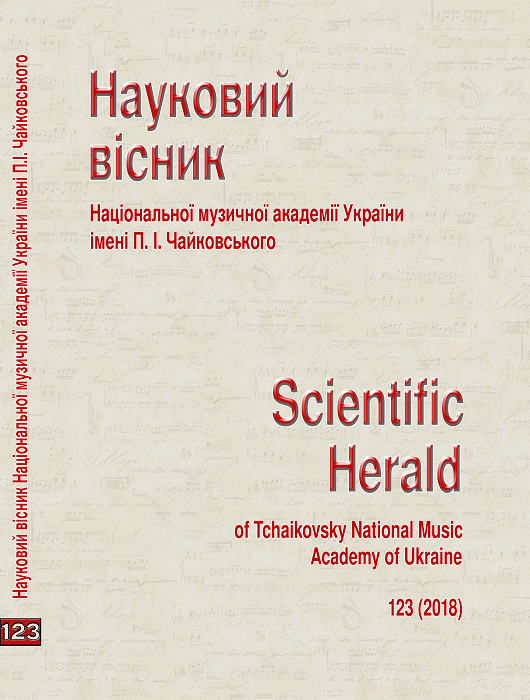National musical traditions in the piano oeuvre of Joaquin Turina
DOI:
https://doi.org/10.31318/2522-4190.2018.123.152424Keywords:
the oeuvre of J. Turina, folklore, national traditions, Renacimiento, patternAbstract
Relevance of the study. In the modern musical continuum, the tendency to search for a terra incognita – the discovery of unexplored pages in the history of musical art – projects the works, facts, names of little-studied or little-known composers into the focus of musicology and performing practice. One of these is the Spanish composer Joaquin Turina (1881–1949), whose creativity occupies a prominent place in the musical culture of Spain (he wrote a little more than a hundred opuses), but undeservedly remains poorly researched in the Ukrainian musicology. It determines the relevance of the study and open up the scientific perspectives for the first investigations in this direction for the author of the article.
Main objective of the study. The aim of the article is to highlight the peculiarities of the embodiment of national traditions in the piano creativity of J. Turina through defining and structuring the characteristic Spanish stylistic figures of the musical language – patterns.
Methodology of the study. To achieve this goal, the following scientific approaches were used: historiographic (for studying historical research on this issue), bibliographic (for compiling a list of sources and books, their scientific description), historical typological (for clarifying the Renacimiento period in Spain) and analytical (for identifying the Spanish stylistic figures of the musical language in the work).
Results and conclusions. Systematic appeal of the composers of Spain to folk sources helped to determine the following professional methods of the embodiment of Spanish folklore into musical themes: citing and associative. J. Turina in the “Symphonic Rhapsody” applies the second method, which is inextricably linked with the use of characteristic patterns. The results of the study are perspective in the field of research of the Spanish and world musical culture; they can be extrapolated to the works of both national and foreign composers who turn to the Spanish folklore sphere in their works.
Downloads
References
Golovinskiy, G. (1981), Kompozitor i folklor: Iz opyita masterov XIX–XX vekov. Ocherki [in Russian] [Composer and folklore: The experience of the masters of the XIX–XX centuries. Essays]. Moscow: Muzyika. 279 p.
Debyussi, K. (1964), Stati. Retsenzii. Besedyi [in Russian] [Articles. Reviews. Conversations]. Moscow, Leningrad: Muzyika. 278 p.
Zemtsovskiy, I. (1978), Folklor i kompozitor. Teoreticheskie etyudyi [in Russian] [Folklore and composer. Theoretical studies]. Leningrad: Sov. Kompozitor. 176 p.
Martyinov, I. (1977), Muzyika Ispanii [in Russian] [The Music of Spain]. Moscow: Sov. Kompozitor. 376 p.
Ossovskiy, A. (1961), Ocherk istorii ispanskoy muzyikalnoy kulturyi [in Russian] [An Essay on the history of Spanish music culture]. Leningrad : Sov. Kompozitor. pp. 227–288.
Busto, J., del. (2009), Joaquín Turina. [online] Available at: http://www.orcam.org. [Accessed 25 Nov. 2016].
Fundación Juan March (1991), Joaquín Turina, a través de otros escritos. Un repertorio de escritos dedicados al músico sevillano en el transcurso de casi un siglo por Alfredo Morán. Biblioteca de Música Española Contemporánea. Madrid : Ediciones Peninsular. Tomelloso, 37. 28026 Madrid. 260 p.
Marco, T. (1993), Spanish Music in the Twentieth Century. Cambridge, Massachusetts. London, England: Harvard University Press. 288 p.
Op. 66 Rapsodia sinfónica. Ciclo pianístico, V. (1931), [online]. Archivo Joaquín Turina. Available at: http://www.joaquinturina.com/opus66.html. [Accessed 10 Oct. 2017].
Downloads
Published
How to Cite
Issue
Section
License
Our journal abides by the CREATIVE COMMONS copyright rights and permissions for open access journals.
Authors, who are published in this journal, agree to the following conditions:
The authors reserve the right to authorship of the work and pass the first publication right of this work to the journal under the terms of a Creative Commons Attribution License, which allows others to freely distribute the published research with the obligatory reference to the authors of the original work and the first publication of the work in this journal.
The authors have the right to conclude separate supplement agreements that relate to non-exclusive work distribution in the form in which it has been published by the journal (for example, to upload the work to the online storage of the journal or publish it as part of a monograph), provided that the reference to the first publication of the work in this journal is included.




